Excavation Contractors East Moline
Top 10 Excavation Company Near Me in East Moline
Get up to 3 Land Excavation quotes for your project today! Compare profiles, reviews, accreditations, portfolio, etc... and choose the best deal.

Always Underground Inc
3.316 reviews20603 Burl Court, 20603 Burl Ct, Joliet, 60433, USBuilding Trust with Quality Work Respected for our integrity, Gold Shovel Standard certified for safety About Us AUI is a full service Woman Owned Business, design build utility construction company specializing in wireless /wireline, aerial and underground projects. With over 60 years of experience AUI has been providing 24/7 emergency response to the most challenging of projects. Our design, build, turn-up and test teams are well positioned throughout Illinois, Indiana, Wisconsin, Michigan, Iowa, Ohio, Kentucky and eastern Missouri to be able to assist now. Our emergency response crews have mobilized to support storm damage and other natural disasters for decades. Please see our Services tab and check out our capabilities Working Together We offer an end-to-end client experience that includes seamless communication, budgeting, staffing, on-site organization, and solid, quality construction every time. Our relationships with over 80 jurisdictions in the Midwest provide our clients peace of mind their projects will be completed on time and on budget. Why Choose Us? We work with all stake holders to bring quality, infrastructure Projects to life. Call us today and bring our project management skills and extensive construction experience to your next project.
- Services
- Why Us?
- Gallery
Get Quote
J.G Gagnon & Son's Excavation L.L.C
44 reviewsEpping, New Hampshire, United States, USJ.G. GAGNON & SON’S EXCAVATION L.L.C. We take pride in all the jobs we do. With 30 years of experience and pristine work ethics, we give every customer and job 200%. We have a passion, not only for the excavation work itself but, for our customers and their satisfaction! We treat and tackle every job as if it was our own. We take extreme pride in our finished product, always leaving our customers completely satisfied. We’re a small business located in Southern NH and offer services in -
- Services
- Why Us?
- Gallery
Get Quote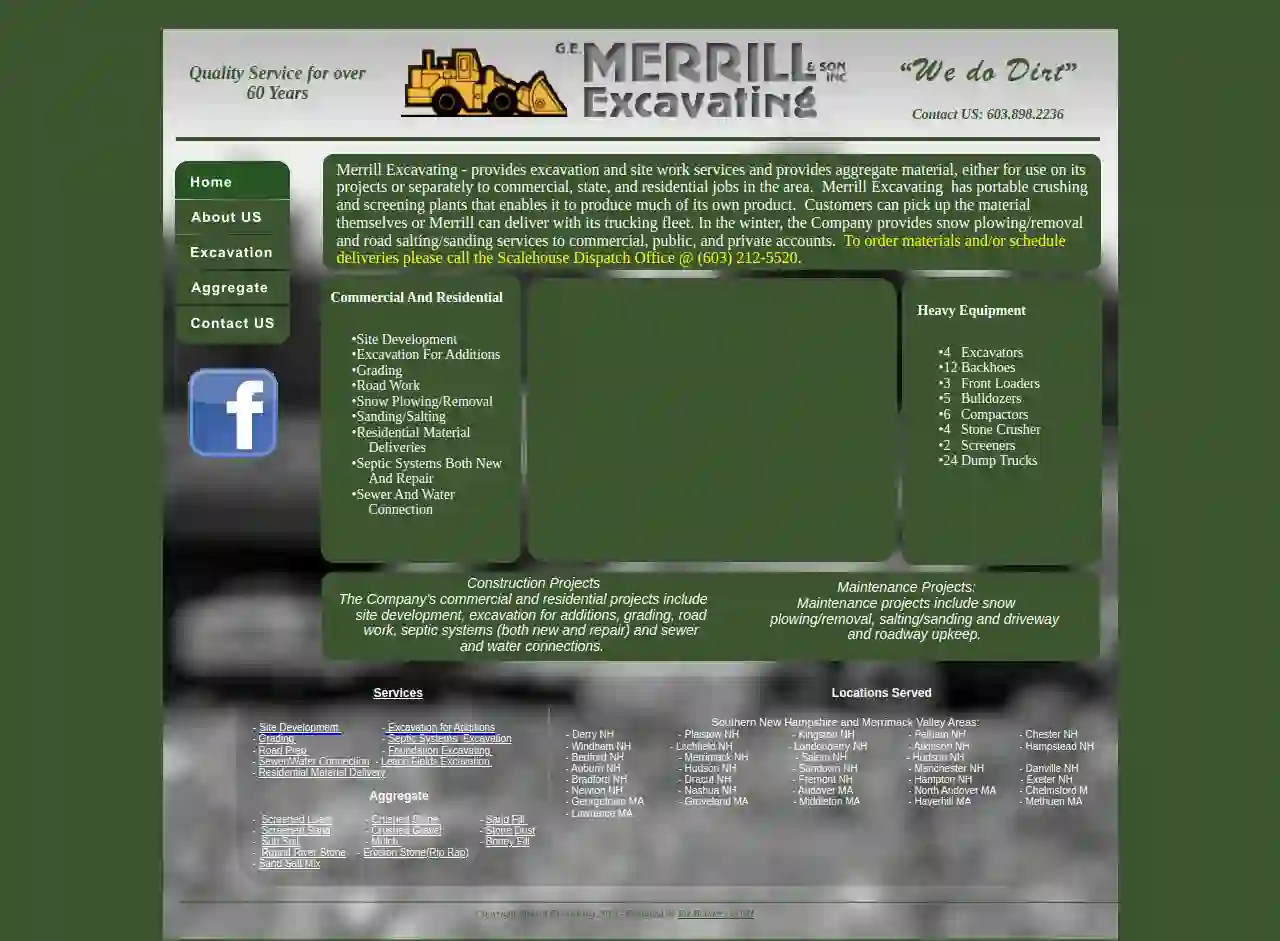
Merrill Excavating
425 reviews38 School Street, Salem, 03079, USMerrill Excavating - Quality Since 1953! Over the past 60 years Merrill Excavating has evolved with the needs of our community and its people. Our commitment keeps our business both a leader and trusted name in our local community. History George E. Merrill founded the company in 1953 with humble beginnings - one tractor and one employee. Under his direction and determined efforts, the company would grow to become an essential member of the local construction community. In 1980, his son George D. took over the company and started to expand its products and services to meet the changing needs of its growing community and customer base. Since George D. Merrill's retirement, his sons Gary and Jonathan have run the company, which now has over 45 employees and a large inventory of equipment suited to any job, large or small. The company also has a sand and gravel pit located in Salem, NH. To order materials and/or schedule deliveries please call the Scalehouse Dispatch Office @ (603) 212-5520.
- Services
- Why Us?
- Gallery
Get Quote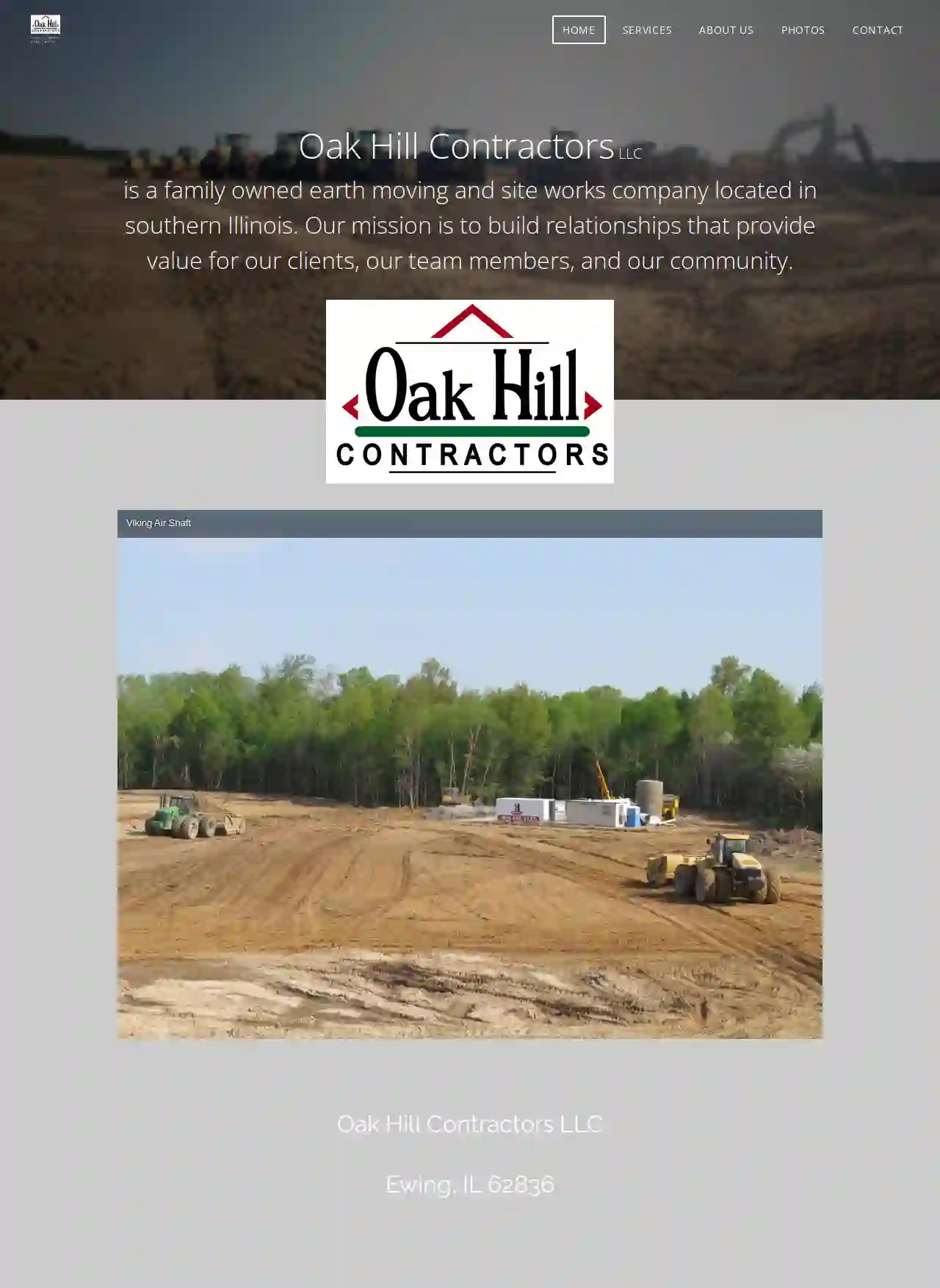
Oak Hill Contractors LLC
53 reviews20245 Ewing Road, Ewing, 62836, USAbout Oak Hill Contractors LLC Oak Hill Contractors LLC is a family-owned earth moving and site works company based in southern Illinois. We are dedicated to building strong relationships with our clients, team members, and the community, ensuring value for everyone involved. Our commitment to quality work and a wide range of equipment allows us to handle projects of all sizes. We utilize GPS-equipped machines for efficient and accurate grading work, ensuring precision and timely completion. We are proud to be Prequalified by IDOT and have MSHA-trained personnel. We are also fully insured, providing peace of mind to our clients. Take a look at one of our recent projects: Sugar Camp Refuse Expansion.
- Services
- Why Us?
- Gallery
Get Quote
F.L. Merrill Construction, Inc.
51 reviews35 Veterans Drive, Loudon, 03275, USProudly Serving New Hampshire Since 1990. Located In Loudon, NH Family Owned & Operated NH Construction Company Get A Quote Municipal Construction We specialize in road construction for small local subdivisions. Our expertise includes building, constructing, & repairing roadways. Commercial Construction Our New Hampshire commercial construction experience includes land clearing, site work, utility installation, and more. Residential Construction Whether you need help with excavation for a new septic system or any other excavation need, our team has 25+ years of experience. Who We Are A Dedicated Team Of Construction Experts F.L. Merrill Construction's success is built on a foundation of hard work and dedication, values that are shared by everyone from upper management to construction crew members. Frank and Sue Merrill realized their ability to provide customers with a superior service comes down to their team who are consider to be an extension of their family. By investing in its people, Merrill Construction has established itself as a NH construction industry leader for over three decades. Tell us about your project! Land Clearing Site Work Utility Installation Road Construction Bridge Construction Footing Foundations Residential Excavation Materials Supply Trucking & Dumping Get A Free Quote Today! Get A Quote
- Services
- Why Us?
- Testimonials
- Gallery
Get Quote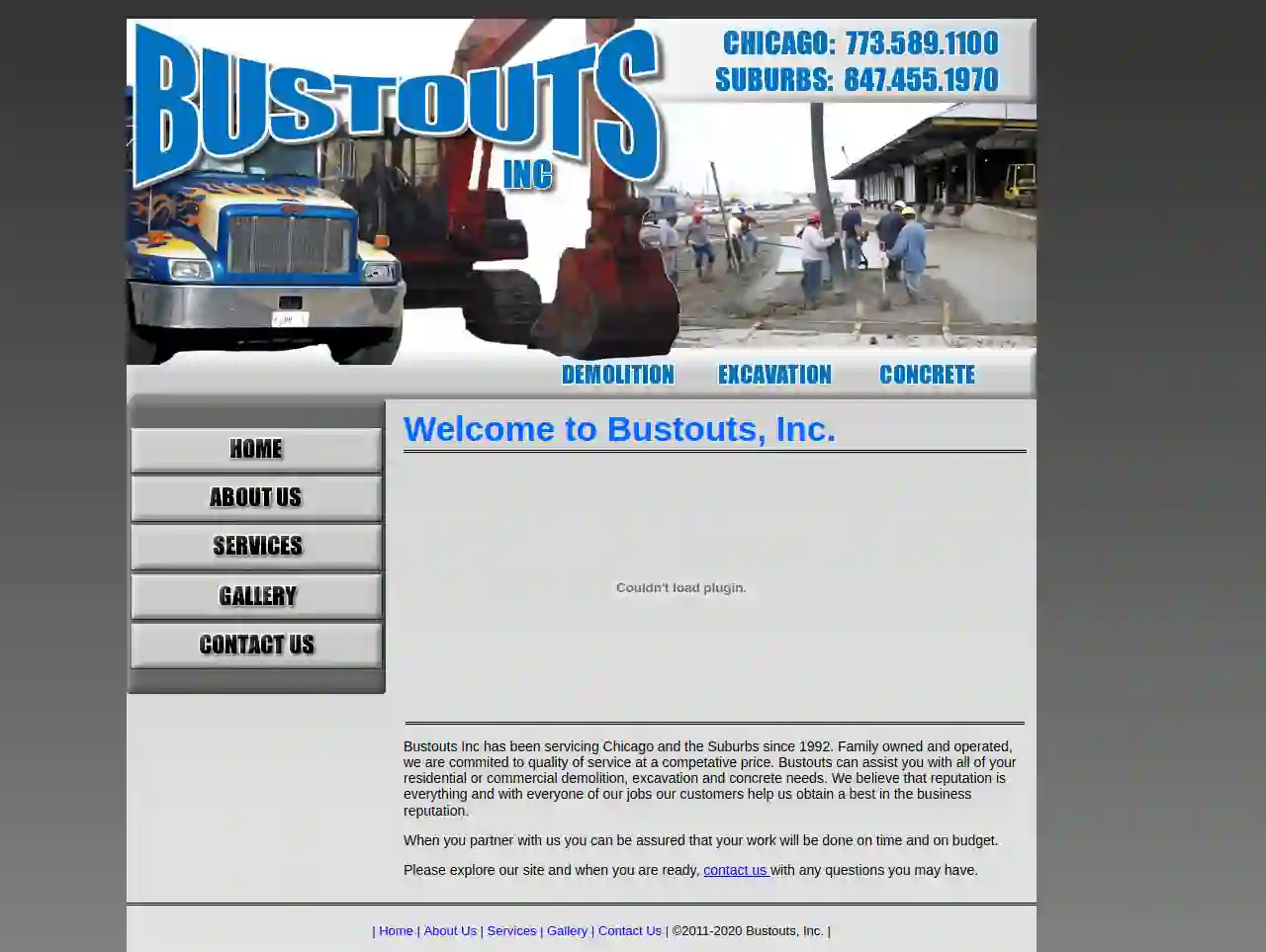
Bust Outs Inc
32 reviewsChicago, USAbout Bustouts, Inc. Bustouts Inc has been serving Chicago and the suburbs since 1992. As a family-owned and operated business, we are committed to providing high-quality services at competitive prices. We specialize in residential and commercial demolition, excavation, and concrete work. Our reputation is everything, and we strive to deliver exceptional results on every project, ensuring customer satisfaction and building a strong reputation in the industry. When you choose Bustouts, Inc., you can trust that your project will be completed on time and within budget. Explore our website to learn more about our services and don't hesitate to contact us with any questions you may have.
- Services
- Why Us?
- Gallery
Get Quote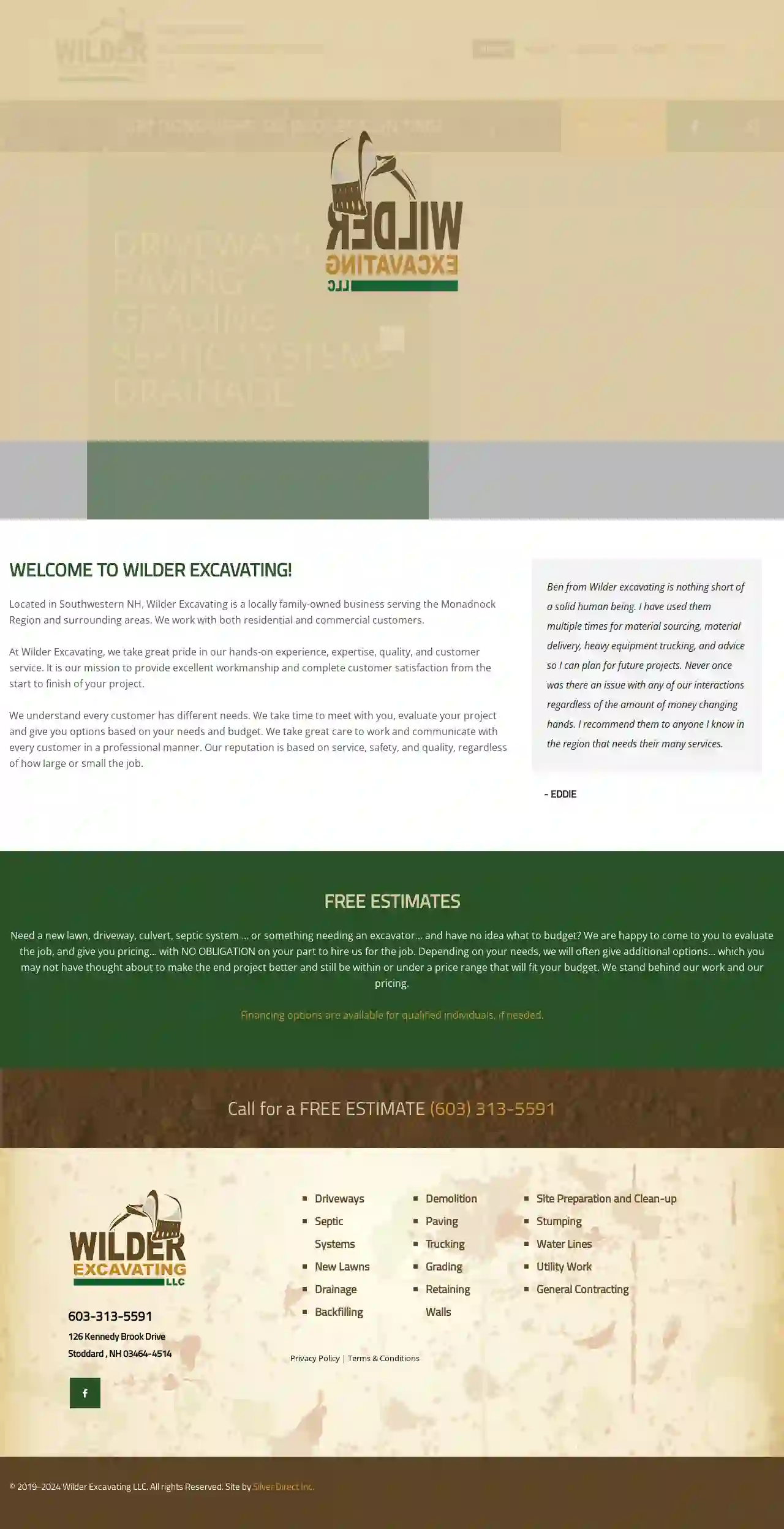
Wilder Excavating LLC
52 reviews126 Kennedy Brook Drive, Stoddard, 03464-4514, USWelcome to Wilder Excavating! Located in Southwestern NH, Wilder Excavating is a locally family-owned business serving the Monadnock Region and surrounding areas. We work with both residential and commercial customers. At Wilder Excavating, we take great pride in our hands-on experience, expertise, quality, and customer service. It is our mission to provide excellent workmanship and complete customer satisfaction from the start to finish of your project. We understand every customer has different needs. We take time to meet with you, evaluate your project and give you options based on your needs and budget. We take great care to work and communicate with every customer in a professional manner. Our reputation is based on service, safety, and quality, regardless of how large or small the job. Ben from Wilder excavating is nothing short of a solid human being. I have used them multiple times for material sourcing, material delivery, heavy equipment trucking, and advice so I can plan for future projects. Never once was there an issue with any of our interactions regardless of the amount of money changing hands. I recommend them to anyone I know in the region that needs their many services. - Eddie FREE ESTIMATES Need a new lawn, driveway, culvert, septic system … or something needing an excavator… and have no idea what to budget? We are happy to come to you to evaluate the job, and give you pricing… with NO OBLIGATION on your part to hire us for the job. Depending on your needs, we will often give additional options… which you may not have thought about to make the end project better and still be within or under a price range that will fit your budget. We stand behind our work and our pricing. Financing options are available for qualified individuals, if needed. Call for a FREE ESTIMATE (603) 313-5591
- Services
- Why Us?
- Testimonials
- Gallery
Get Quote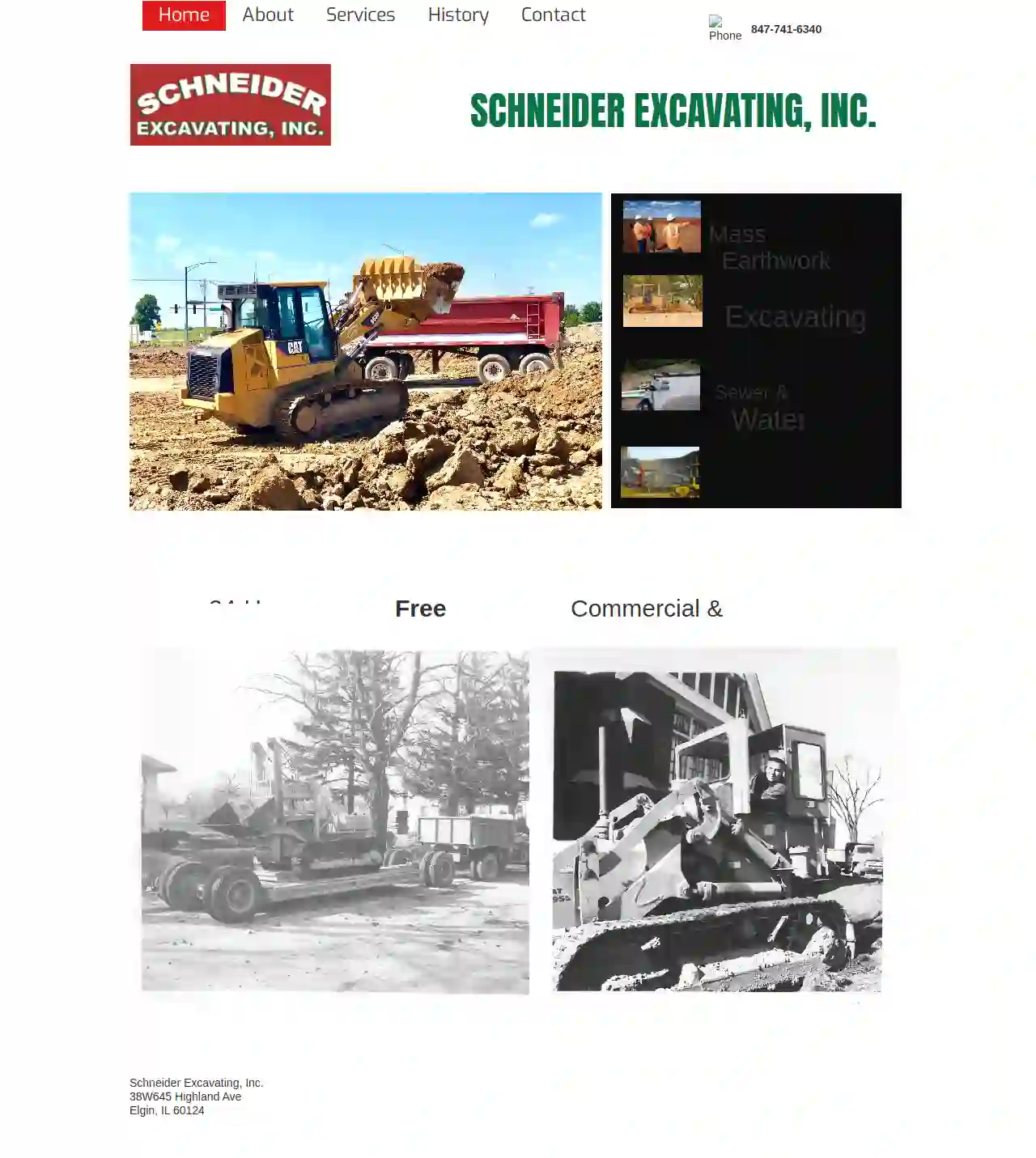
Schneider Excavating Inc.
52 reviews38W645 Highland Ave, Elgin, 60124, USAbout Schneider Excavating, Inc. Established in 1932, Schneider Excavating, Inc. strives to be the go-to company for all your excavation needs. We specialize in Mass Earthwork, Excavating, Sewer & Water, and Demolition, offering a level of expertise that sets us apart from other contractors. With over 85 years of experience, we've become experts in excavating for virtually any project. Beyond our contracting certifications, we adhere to strict industry guidelines, incorporating standards set by the EPA and OSHA. This commitment ensures every project detail is addressed, resulting in exceptional work. We are dedicated to doing right by those who place their trust in us. Proudly serving Elgin & the Fox Valley since 1932, Schneider Excavating, Inc. is here to assist you, whether you have a 50-acre site requiring hundreds of thousands of cubic yards of earth movement or a small municipal site with minor infrastructure additions. Many of our clients are Design/Build contractors with projects ranging from 30,000 square feet to a million square feet. We work closely from budget to build-out, ensuring we stay on schedule and within budget. We have collaborated with a wide range of Contractors, Project Managers, Engineering Firms, Architects, and Private Companies in and around the Elgin area. No matter the size, scope, or uniqueness of your project, we can provide references for your specific type of work. Feel free to contact us anytime!
- Services
- Why Us?
- Our Team
- Testimonials
- Gallery
Get Quote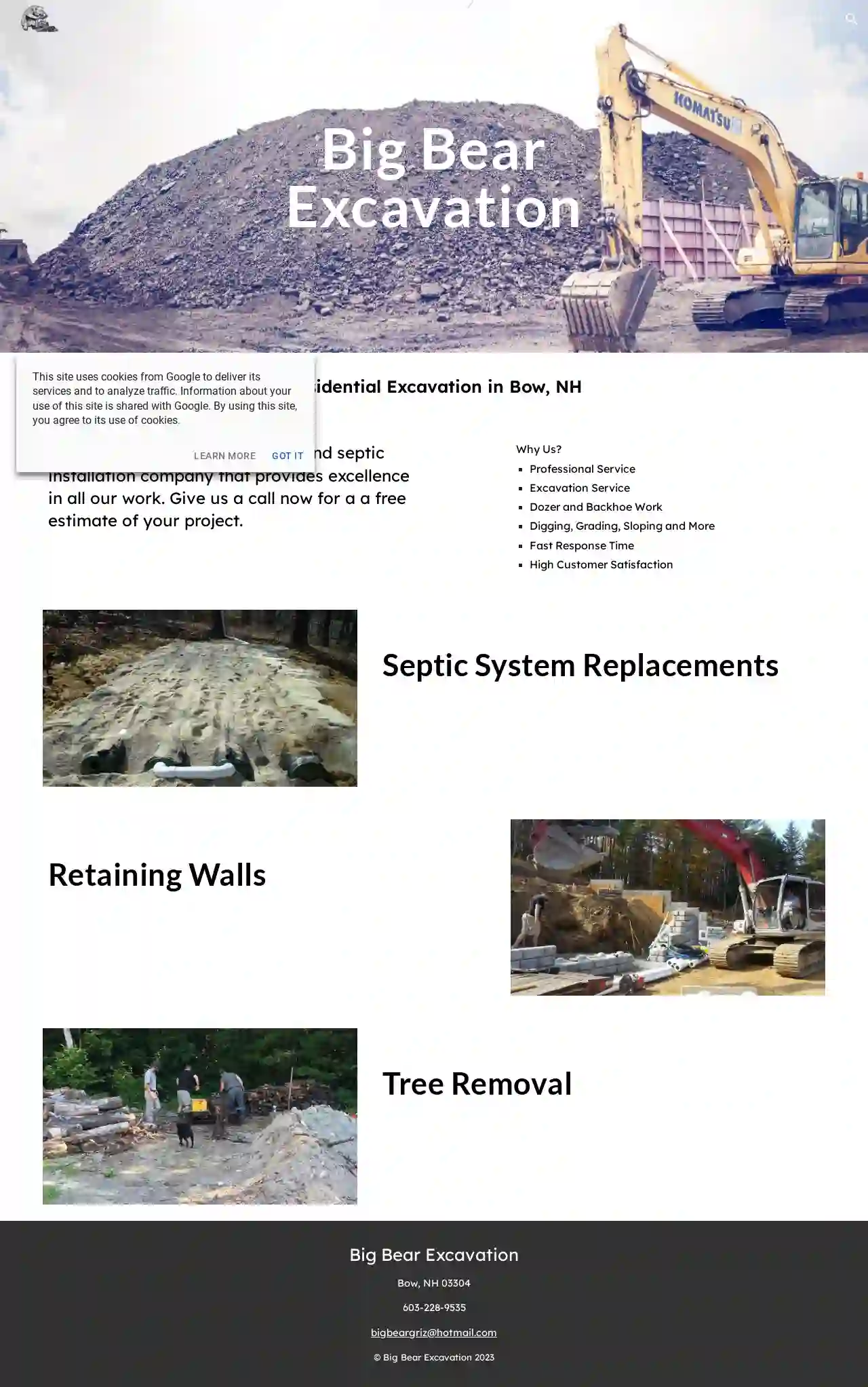
Big Bear Excavation
51 reviewsBow, 03304, USBig Bear Excavation We are a residential excavation and septic installation company that provides excellence in all our work. Give us a call now for a free estimate of your project. Why Us? Professional Service Excavation Service Dozer and Backhoe Work Digging, Grading, Sloping and More Fast Response Time High Customer Satisfaction Septic System Replacements Retaining Walls Tree Removal
- Services
- Why Us?
- Gallery
Get Quote
McHenry Excavating, Inc
4.934 reviews1903 State Rte 31, Suite A, McHenry, 60050, USWelcome to McHenry Excavating, Inc. Commercial & Residential Demolition Pool & Concrete Removal Excavation Sewer & Water Grading Hauling & Removal Helical Piles Under-Pinning Chicagoland’s 24/7 Demolition and Excavation Experts As the Chicagoland area’s demolition and excavation experts since 2006, McHenry Excavating, Inc. is a family-owned and -operated company specializing in residential, commercial and industrial services. Serving McHenry, Lake, DuPage and Cook Counties alike, we’re also highly skilled in grading, dredging, hauling, trenching and concrete removal services. No job is too challenging for our experienced crew. Whether you have a short project timeline or a small budget to work with, give us a call to see what we can do for you. ABOUT US If We Can’t Do It, It Can’t Be Done We take great pride in providing outstanding customer service and support and have the expertise, professionalism, and experience necessary to complete every job safely and efficiently. Because we understand that no two projects are ever the same, we make it our mission to identify your every need to precisely execute your projects to your complete satisfaction. From your project’s conception to its completion, we’re there for you every step of the way! No matter how large or small, you can rest assured that you’re always in good hands when you choose McHenry Excavating, Inc. to handle your project. CONTACT US Why Choose McHenry Excavating, Inc.? Certified, Licensed & Bonded 24/7 Emergency Response Free In-Home/On-Site Estimates 100% Customer Satisfaction Reliable & Affordable Pricing Utmost Commitment to Safety No Project’s Too Large or Too Small Experienced and Trained Staff
- Services
- Why Us?
- Testimonials
- Gallery
Get Quote
Over 22,076+ Excavation Pros onboarded
Our excavation pros operate in East Moline & surroundings!
ExcavationHQ has curated and vetted the Best Excavation Contractors in East Moline. Find a reliable business today.
Frequently Asked Questions About Excavation Contractors
- Project Size and Scope: Larger, more complex excavations naturally take longer.
- Soil Conditions: Rocky or challenging soil types can slow down progress.
- Site Accessibility: Limited access might require more time for maneuvering equipment and hauling materials.
- Weather: Inclement weather can cause delays.
- Permitting and Inspections: Waiting for permits or inspections can extend the timeline.
- Project Type and Size: Ensure the contractor has experience handling projects similar to yours in scale and complexity.
- Reputation and Reviews: Check online reviews and testimonials, and request references from previous clients.
- Licensing and Insurance: Verify that the contractor is properly licensed and insured to protect you from liability.
- Equipment and Resources: Confirm that they have the necessary equipment and resources for your project's needs.
- Communication and Transparency: Choose a contractor who communicates clearly, provides detailed estimates, and keeps you informed throughout the project.
- Safety Record: Inquire about their safety protocols and track record to ensure a safe work environment.
- Price: While price is important, it shouldn't be the only deciding factor. Balance affordability with experience, reputation, and quality of service.
- Excavations Deeper Than a Certain Depth: This varies by jurisdiction, usually around 5 feet.
- Excavations Near Utilities: Digging near buried utilities (gas, water, electric) often requires permits and utility locates to prevent damage.
- Excavations Affecting Public Property: Projects impacting sidewalks, roads, or other public areas typically require permits.
- Excavations in Environmentally Sensitive Areas: Projects in wetlands, floodplains, or other sensitive areas might need special permits.
- Mechanical Excavation: Utilizing heavy equipment like excavators, backhoes, bulldozers, and loaders, suitable for most projects.
- Hand Excavation: Using hand tools (shovels, picks) for smaller excavations or delicate work near utilities.
- Blasting: Employing explosives to break up rock or hard materials, typically for large-scale projects.
- Hydro Excavation: Using high-pressure water jets to loosen and remove soil, often used for locating utilities or delicate excavation.
- Vacuum Excavation: Employing a vacuum system to suck up excavated material, suitable for safe excavation near utilities or in confined spaces.
How long does an excavation project take?
How do I choose the right excavation contractor for my project?
Do I need a permit for excavation?
What are the different methods of excavation?
How long does an excavation project take?
- Project Size and Scope: Larger, more complex excavations naturally take longer.
- Soil Conditions: Rocky or challenging soil types can slow down progress.
- Site Accessibility: Limited access might require more time for maneuvering equipment and hauling materials.
- Weather: Inclement weather can cause delays.
- Permitting and Inspections: Waiting for permits or inspections can extend the timeline.
How do I choose the right excavation contractor for my project?
- Project Type and Size: Ensure the contractor has experience handling projects similar to yours in scale and complexity.
- Reputation and Reviews: Check online reviews and testimonials, and request references from previous clients.
- Licensing and Insurance: Verify that the contractor is properly licensed and insured to protect you from liability.
- Equipment and Resources: Confirm that they have the necessary equipment and resources for your project's needs.
- Communication and Transparency: Choose a contractor who communicates clearly, provides detailed estimates, and keeps you informed throughout the project.
- Safety Record: Inquire about their safety protocols and track record to ensure a safe work environment.
- Price: While price is important, it shouldn't be the only deciding factor. Balance affordability with experience, reputation, and quality of service.
Do I need a permit for excavation?
- Excavations Deeper Than a Certain Depth: This varies by jurisdiction, usually around 5 feet.
- Excavations Near Utilities: Digging near buried utilities (gas, water, electric) often requires permits and utility locates to prevent damage.
- Excavations Affecting Public Property: Projects impacting sidewalks, roads, or other public areas typically require permits.
- Excavations in Environmentally Sensitive Areas: Projects in wetlands, floodplains, or other sensitive areas might need special permits.
What are the different methods of excavation?
- Mechanical Excavation: Utilizing heavy equipment like excavators, backhoes, bulldozers, and loaders, suitable for most projects.
- Hand Excavation: Using hand tools (shovels, picks) for smaller excavations or delicate work near utilities.
- Blasting: Employing explosives to break up rock or hard materials, typically for large-scale projects.
- Hydro Excavation: Using high-pressure water jets to loosen and remove soil, often used for locating utilities or delicate excavation.
- Vacuum Excavation: Employing a vacuum system to suck up excavated material, suitable for safe excavation near utilities or in confined spaces.